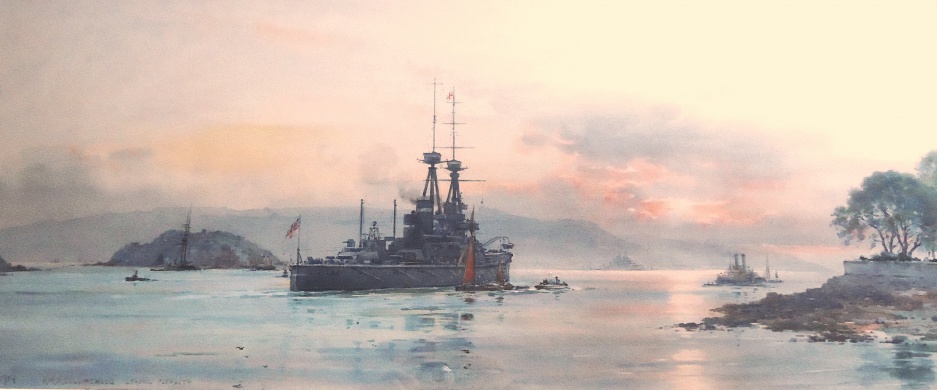HMS COLLINGWOOD Leaving Plymouth, summer 1914
. Watercolour signed and dated 1914 and annotated HMS COLLINGWOOD Leaving Plymouth (LL).
29.5 x 12.5 inches (74.93 x 31.75 cms) approx
Price: £2,500 (all inclusive)
This original has been sold and is no longer available.
Prints of this may be available on: Maritime Prints.
Another beautiful scene of Plymouth Sound showing the north east corner of the spot around Widerness Point, Mount Edgcumbe and with Drake's Island just to the left of the battleship's stern and, in the background, Plymouth Sound and Staddon Heights. Its early morning and one of the King's ships is departing. How Frank Wood seemed to love this spot and never more so than when a large man-of-war was entering or leaving harbour with paddle tugs and other smaller craft fussing around her as she carefully picks her way along the sinuous buoyed channels that are the hallmark of this large estuary and its harbours and coves.
HMS COLLINGWOOD, one of three St Vincent Class dreadnoughts, was built by HM Dockyard Devonport and launched on 7 November 1908. 536 feet long and with a main armament of 10 x 12 inch/50 calibre guns, she was commissioned into the 1st Division of the Home Fleet by Captain William Pakenham on 19 April 1910. Some 8 months later, in February 1911, she briefly touched an uncharted rock off Ferrol, Spain; in June 1912 she became flagship of the 1st Battle Squadron.
We see COLLINGWOOD here in 1914 (dated by the artist) in the Narrows with Cremyll and Wildernes Point to starboard, to port Devil's Point (and behind and in the background the city of Plymouth) and what is almost certainly the West Vanguard buoy just visible close to port of the battleship. She is about to start a tight turn to port around Vanguard Bank and will then shape a northeasterly course up into into Drake Channel. COLLINGWOOD is wearing at the fore the flag of a vice admiral which enables us to date the painting in 1914 pretty precisely. The trees on the right are in leaf and so its at least mid April, could be early May; on 22nd June Vice Admiral the Hon Sir Stanley Colville KCB CVO (VA Commanding 1 BS) hauled down his flag and COLLINGWOOD ceased to be a flagship and so the painting shows the ship sometime in a 2 month timeframe, mid April - 22 June of that fateful year of World War 1, 1914, before the admiral struck his flag. In command was Captain James Ley who had the unusual distinction of commanding the battleship for over 4 years including when COLLINGWOOD was in the line at Jutland with Sub Lieutenant HRH The Duke of York (later King George VI) serving onboard......
Having survived the war and by now transferred to the 4th Battle Squadron, HMS COLLINGWOOD was reduced to Reserve at Devonport on 1st June 1920 and was sold for scrap in December 1922.
